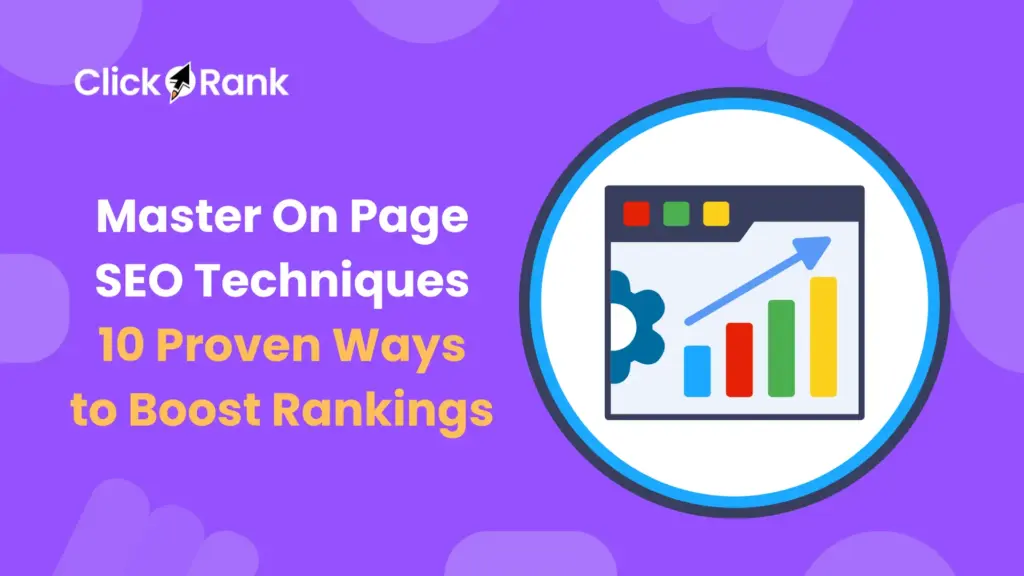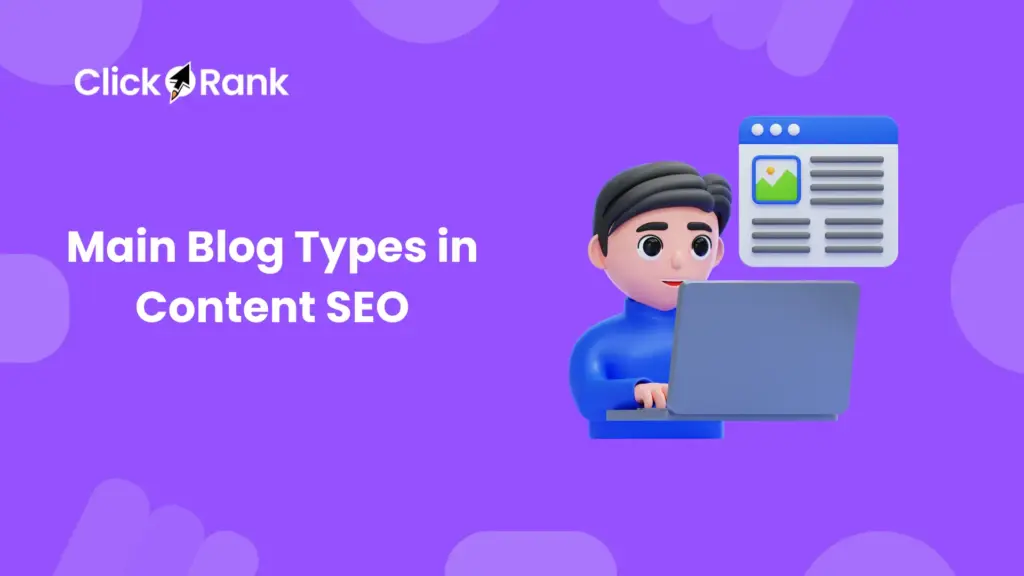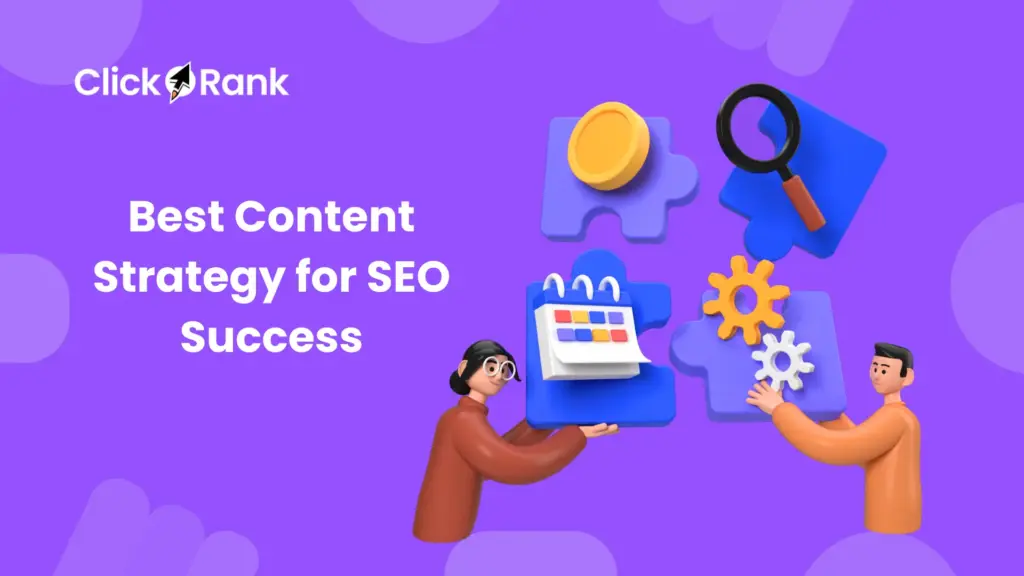It’s a big problem when you spend a lot of time and money creating great content, but it doesn’t show up in Google search results. You write helpful articles and blog posts, but they end up buried on the later pages where customers can’t find them.
This means your effort and investment aren’t paying off. The solution isn’t just to write more and more content. The better way is to improve the SEO of the content you already have, making it work harder for you and bring more visitors to your website.
This is where content optimization comes in. It’s the process of enhancing your existing content to make it more attractive, useful, and visible to both search engines and users. Think of it this way: Content marketing creates the value, and search engine optimization ensures it gets found. A solid content optimization strategy is the bridge between the two. It’s no longer optional for anyone serious about driving organic search traffic. And today, with the rise of AI-powered platforms, it’s faster and more effective than ever before.
In this guide, we’ll break down a clear, actionable framework for content optimization. You’ll learn how to diagnose underperforming content, implement critical on-page and technical fixes, and measure your success. More importantly, you’ll discover how to automate the most tedious parts of this process, freeing you up to focus on what you do best: creating high-quality content that establishes you as a thought leadership authority in your industry.
What is Content Optimization? (And Why It’s Crucial for SEO)
Content optimization is a systematic process of refining your content to improve its performance in search engine results pages (SERPs). It’s about ensuring that every piece of content you publish has the best possible chance of ranking for its target keywords, attracting the right audience, and driving meaningful results like increased website traffic, better engagement, and more leads.
Beyond Keywords: The True Scope of Content Optimization in SEO
Many people hear “content optimization” and immediately think of keyword stuffing. While keyword research is a foundational piece of the puzzle, true optimization goes much deeper. It’s a holistic approach that covers a wide range of factors, including:
- Matching search intent: Ensuring your content provides the answer the user is looking for when they type a query into Google.
- Improving readability and structure: Using clear headings, short paragraphs, and formatting elements like bullet points and bolding to make your content easy to consume.
- Enhancing on-page elements: Crafting compelling meta titles, descriptions, and image alt text to improve click-through rates from the SERPs.
- Ensuring technical soundness: Implementing schema markup to help search engines understand your content better and building a strong internal linking structure to guide both users and crawlers through your site.
What is an example of content optimization?
Let’s look at a simple, relatable example to illustrate the power of content optimization.
- Before: A company publishes a blog post with the title “Our New Product.” The article is well-written, but the title is vague, the meta description is auto-generated, and it lacks any real targeting. It gets lost in the digital noise.
- After: The same blog post is optimized. The title is changed to “The Ultimate Guide to Choosing the Best X for Y in 2025.” It now includes an optimized meta description that highlights the key benefits for the user. Alt text is added to all the images, making them accessible and discoverable in image search. Internal links are added to related service pages, creating a more cohesive user journey. The result? The article starts ranking for relevant keywords, attracting qualified traffic, and generating leads for the new product.
This is the transformative power of a well-executed content optimization strategy. It’s not about tricking search engines; it’s about creating a better experience for your users, which in turn leads to better SEO outcomes.
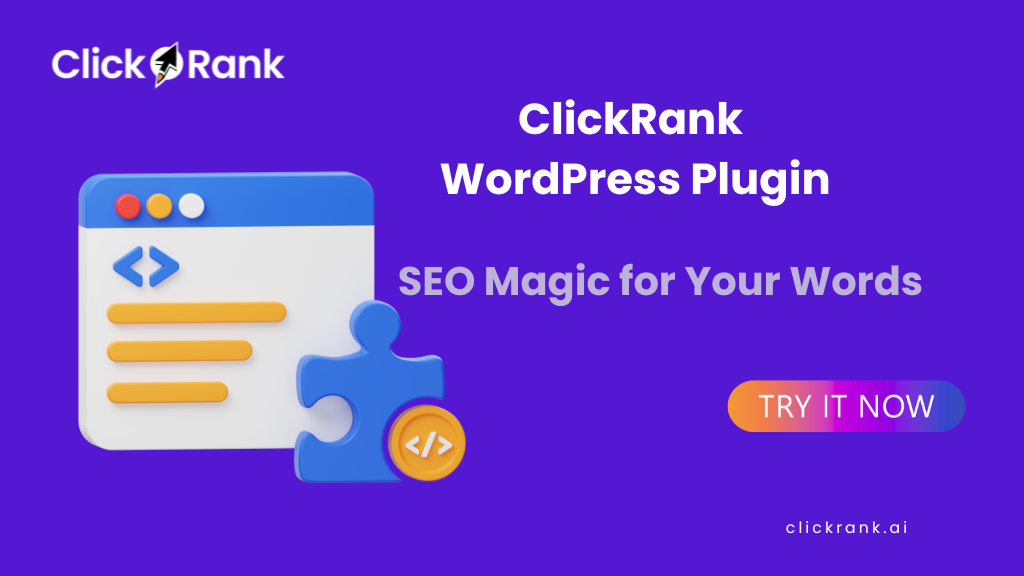
How Can You Unlock Premium Features with ClickRank.ai WordPress Plugin Today?
The ClickRank.ai WordPress plugin is engineered to bring the full force of our AI-driven optimization directly to your WordPress backend. It automates the most critical and time-consuming aspects of on-page SEO, allowing you to focus on creating exceptional content while our technology works to maximize your visibility and search engine rankings.
How it Works:
Once installed, the ClickRank.ai plugin securely connects your WordPress site to our platform via an API key. This allows for a two-way communication channel where your site’s content is analyzed, and AI-generated optimizations are automatically implemented.
What’s the Difference Between On-Page and Off-Page SEO?
Before we dive deeper into our 5-step strategy, it’s important to understand the distinction between On-Page SEO and Off-Page SEO.
On-Page SEO refers to all the optimization efforts you make directly on your website to improve its ranking. This includes everything we’ve discussed so far: content quality, keyword optimization, title tags, meta descriptions, internal linking, and content structure. You have direct control over these factors.
Off-Page SEO, on the other hand, involves actions taken outside of your own website to impact your rankings within the SERPs. The most significant part of off-page SEO is building backlinks. These are links from other websites to yours, and they act as a vote of confidence in the eyes of search engines. Other off-page signals include brand mentions, social media engagement, and guest blogging.
While both are critical for a comprehensive SEO strategy, our focus in this guide is on on-page content optimization. Why? Because it’s the area where you have the most control and can make the most immediate impact. By mastering on-page SEO, you create a solid foundation that makes all your off-page efforts, like link building, far more effective. You can’t build a great house on a weak foundation, and the same is true for your SEO.
How Does Content Optimization Impact Your Results? A Before and After Comparison
Content optimization can dramatically improve your SEO results and user engagement. The table below shows clear before-and-after examples, highlighting how small changes to titles, meta descriptions, keyword usage, headings, and images can transform your content’s performance. Use these examples to guide your own optimization process and see measurable improvements in rankings, click-through rates, and overall visibility.
| Factor | Before Optimization Example | After Optimization Example |
| Title | “Tips for Websites” | “10 Proven SEO Tips to Boost Your Website Traffic” |
| Meta Description | Missing or “Welcome to our website” | “Learn 10 SEO tips to increase traffic and rank higher fast.” |
| Keyword Usage | “law firm SEO” repeated too often in one paragraph | “law firm SEO” used naturally across headings and text |
| Headings | All text in one block | H1, H2, and H3 headings with descriptive keywords |
| Images | Large image, no alt text | Compressed image with alt text “SEO tips for lawyers” |
What Are the 5 Essential Steps for an SEO Content Optimization Strategy That Delivers Results?
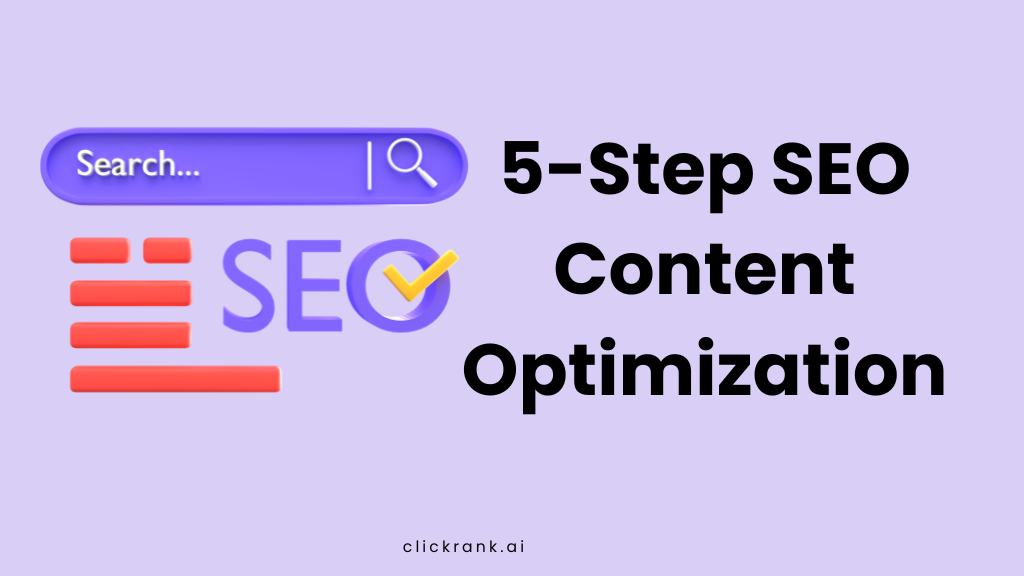
Now, let’s get into the practical, step-by-step framework you can use to optimize your content. This is the same process that top-performing content teams use to dominate the search results.
Step 1: Conduct a Content Audit to Find Opportunities
You can’t fix what you don’t know is broken. The first step is to conduct a content audit to identify underperforming pages. These are often pages with high impressions but low clicks, or pages that are stuck on the second or third page of Google. A manual audit can be incredibly time-consuming, involving spreadsheets and hours of cross-referencing data.
ClickRank.ai in Action: This is where automation becomes a game-changer. ClickRank’s Site Audit feature connects directly to your Google Search Console and automatically detects technical SEO issues and on-page optimization gaps. It hands you a prioritized list of opportunities, so you know exactly where to start.
Step 2: Master On-Page Content Optimization
This is where you’ll roll up your sleeves and do the core hands-on work. On-page optimization involves refining all the elements on the page itself to make it more appealing to both users and search engines.
Search Engine Optimization Content Writing
This starts with your meta title and description. These are the first things users see in the search results, and they play a huge role in whether or not someone clicks on your link. Crafting compelling titles and descriptions that are both keyword-rich and enticing is a critical skill.
ClickRank.ai in Action: Writing the perfect meta title and description is a manual, data-intensive task. ClickRank uses your Google Search Console data to automatically rewrite and optimize your titles and descriptions with one click. It analyzes the keywords your page is already ranking for and crafts a title and description designed to maximize your click-through rate.
Enhancing Readability and Keyword Integration
Once a user clicks through to your page, you need to deliver a great experience. This means using a clear content structure with headers, subheaders, and lists to break up the text. It also means naturally integrating your target keywords and related terms into the content. Remember, quality content that satisfies E-E-A-T (Experience, Expertise, Authoritativeness, and Trustworthiness) is paramount.
ClickRank.ai in Action:
Our platform offers a Keyword Injection feature that intelligently adds relevant keywords to your content without disrupting its flow or meaning. This ensures your content is properly optimized for your target terms without sounding robotic or unnatural.
Optimizing Visuals with Alt Text
Images and other visuals are a crucial part of the user experience, but they also offer a valuable SEO opportunity. Alt text, or alternative text, is the text that describes an image. It’s important for two reasons: it makes your images accessible to visually impaired users who use screen readers, and it helps search engines understand what your images are about, which can help them rank in image search.
ClickRank.ai in Action:
Writing alt text for hundreds of images is a tedious chore. ClickRank uses AI vision recognition to generate SEO-friendly image alt text automatically. This saves you hours of manual work and ensures all your visual content is contributing to your SEO efforts.
Building a Smart Internal Linking Structure
Internal links are links from one page on your website to another. They are incredibly important for SEO because they help search engines understand the relationship between your pages and establish a clear site architecture. They also improve user engagement by guiding visitors to other relevant content on your site.
ClickRank.ai in Action: Finding relevant internal link opportunities can be a manual and time-consuming process. ClickRank provides smart AI-based internal link suggestions to instantly strengthen your site architecture. It analyzes your content and suggests relevant pages to link to, making it easy to build a powerful internal linking strategy.
Step 3: Implement Advanced Technical Markup
Schema markup is a form of microdata that you can add to your website to help search engines understand your content in more detail. When you use schema markup, you can become eligible for SERP features like rich snippets, which are enhanced search results that include extra information like ratings, reviews, and images. These can significantly increase your click-through rate.
ClickRank.ai in Action: Implementing schema markup, especially in JSON-LD format, can be complex and intimidating if you’re not a developer. ClickRank provides one-click generation and injection of Schema Markup, making your pages eligible for rich results without you ever having to touch a line of code. We support various schema types, and you can even use a tool like the All in One Schema plugin for WordPress in conjunction with our platform for even more advanced use cases.
Step 4: Measure Performance and Analyze Results
Content optimization is not a “set it and forget it” activity. You need to track your performance to see what’s working and what’s not. The key metrics to watch in your Google Search Console are impressions, clicks, click-through rate (CTR), and average position. You can also use tools like Ahrefs to track your keyword rankings over time.
Step 5: Iterate and Re-Optimize
Based on your analysis, you’ll want to iterate and re-optimize your content. This is an ongoing process. SEO is constantly evolving, and what works today might not work tomorrow. By regularly revisiting your content and making improvements, you can maintain and improve your rankings over time.
How Can You Automate Your Strategy with Content Optimization AI for the Future?
The 5-step strategy we’ve outlined is the proven path to content optimization success. However, doing it all manually is a massive undertaking. It requires a significant investment of time, resources, and expertise. This is where AI-powered content optimization tools come in.
The Old Way vs. The AI-Powered Content Optimization Way
The old way of doing content optimization involves a lot of manual labor: sifting through data in spreadsheets, writing and rewriting titles and descriptions, and manually searching for internal linking opportunities. It’s slow, tedious, and prone to human error.
The AI-powered way is different. AI tools can analyze massive datasets in seconds, identifying patterns and opportunities that a human might miss. They can automate repetitive tasks, freeing you up to focus on high-level strategy and content creation.
How ClickRank Automates Your Entire Search Engine Optimization Content Workflow
This is where ClickRank truly shines. While other tools give you suggestions, ClickRank gives you results. It’s not just another analysis tool; it’s an execution platform. With a single JavaScript snippet installed on your site, ClickRank can implement its optimizations with a single click.
Here’s how ClickRank automates the entire 5-step strategy:
- Audit: It automatically audits your site and identifies optimization opportunities.
- On-Page Optimization: It rewrites your titles and descriptions, injects keywords, generates alt text, and suggests internal links all with a single click.
- Technical Markup: It generates and injects schema markup without you having to write any code.
- Analysis: It tracks your performance and shows you the impact of its optimizations.
- Iteration: It makes it easy to continuously re-optimize your content based on real-time data.
ClickRank puts your entire on-page SEO strategy on autopilot, allowing you to achieve better results in a fraction of the time.
What Are the Top 5 Actionable Content Optimization Tips for a Quick Boost?
Looking for some quick wins? Here are five actionable content optimization tips you can implement right away for a quick boost in your organic traffic.
- Refresh Old Content: Identify posts with decaying traffic and update them with new information, fresh statistics, and optimized on-page elements.
- Target Featured Snippets: Use a Q&A format and provide clear, concise definitions to increase your chances of capturing the coveted “position zero” in the SERPs.
- Prioritize User Intent: Make sure your content directly answers the user’s query. Go beyond the keywords and think about the “why” behind the search.
- Compress Images: Use a tool like GTMetrix to analyze your page speed and identify opportunities for improvement. Compressing your images is one of the easiest ways to speed up your site, and with a tool like ClickRank, you can handle the alt text automatically.
- Automate What You Can: Use a tool like ClickRank.ai to handle the technical heavy lifting of on-page SEO. This will free you up to focus on creating high-quality, authoritative content that your audience will love. While ChatGPT and Surfer can help with content creation and on-page suggestions, a platform like ClickRank takes it a step further by implementing the changes for you.
What is the difference between on-page and off-page SEO?
On-page SEO includes all the actions you take directly on your website to improve its ranking. This covers optimizing your content, improving meta titles and descriptions, adding alt text to images, and building a smart internal link structure. You have full control over these elements. Off-page SEO refers to actions taken outside your website, with the most important being earning backlinks from other reputable sites to build your authority. A strong on-page foundation makes all of your off-page efforts more effective.
Is content optimization just about adding more keywords?
Not at all. While keyword integration is important, true content optimization is much broader. It's a complete process that includes matching the user's search intent, improving your content's readability with clear structure, enhancing technical elements like schema markup for rich snippets, and optimizing visuals. It's about providing the best possible experience for the user, which in turn signals value to search engines.
What is the most important first step in a content optimization strategy?
The best starting point is a content audit. You need to identify which pages are underperforming before you can fix them. Look for content with high impressions but a low click-through rate (CTR) in your Google Search Console. This tells you that your content is visible but not compelling enough to earn the click. An automated audit is the fastest way to get a clear, prioritized list of opportunities.
How does a platform like ClickRank.ai make content optimization faster?
ClickRank.ai automates the most time-consuming and technical parts of optimization. Instead of you manually sifting through data, writing meta titles, or searching for internal link opportunities, our platform does it in seconds. It connects to your site's data to automatically rewrite titles, generate descriptive alt text for images, and inject schema markup with a single click. This frees up your team to focus on creating high-quality content, not getting stuck on tedious technical tasks.
I have a lot of old blog posts. Is it worth going back to optimize them?
Absolutely. Refreshing old content is one of the quickest ways to get an SEO boost. Your older posts may already have some authority and backlinks. By updating them with fresh information, optimizing the on-page elements, and ensuring the content still matches user intent, you can significantly improve their traffic and rankings. This is often a much faster path to results than creating a brand new piece of content from scratch.
Turn Content Optimization into Your Unfair Advantage
In today’s competitive digital landscape, creating great content is only half the battle. To succeed, you need a continuous content optimization strategy that ensures your content gets seen by the right people at the right time. By following the 5-step framework we’ve outlined, you can systematically improve the performance of your content and drive sustainable organic growth.
The key to scaling these efforts effectively is automation. AI-powered tools like ClickRank are no longer a luxury; they are a necessity for any content team that wants to stay ahead of the curve. By automating the most time-consuming and technical aspects of SEO, you can free yourself up to focus on what truly matters: creating valuable content that builds your brand and grows your business.
Stop just analyzing and start optimizing. Put your entire on-page SEO strategy on autopilot.
Get started with ClickRank.ai today.
